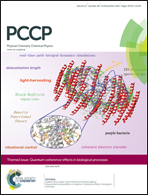Can silicon substituted metal-free organic dyes achieve better efficiency compared to silicon free organic dyes? A computational study†
Abstract
The power conversion efficiency of metal-free organic dyes in dye-sensitized solar cells (DSSCs) is now comparable to ruthenium-based polypyridyl and zinc-based porphyrin dyes. We have computationally investigated the structural, electronic and optical properties of a series of metal free organic dyes and their corresponding silicon substituted dyes. The DFT and TD-DFT calculations revealed that silicon substituted organic dyes have higher efficiency than the corresponding silicon free organic dyes. The computational results showed that the presence of silole units as a spacer group can significantly affect the performance of DSSCs compared to typically using thiophene as a spacer unit. These results corroborate the experimental observations reported in the literature. The time-dependent density functional theory (TDDFT) calculations performed at the CPCM–CAM-B3LYP/6-31+G* level of theory showed better agreement with the experimental absorption spectra of some reported metal free organic dyes having silole in the spacer group compared to other functionals and are employed in this study. Indoline donor based dye 5 showed a much shorter absorption spectrum (absorption peak at 425 nm) and smaller electron injection driving force (ΔGinjection = −1.77 eV) than the corresponding dye 8 containing silicon substituted indoline as a donor and a silole group as a spacer unit. λmax = 502 nm and ΔGinjection = −1.82 eV calculated for dye 8 are much larger than the corresponding silicon free dye 5. The silicon based dye 8 helps in achieving a much lower ΔGregeneration value than 5, which can facilitate the faster electron injection rate from the dye to the semiconductor TiO2. Dye 8 should also have a higher Voc value compared to other dyes (5–7) due to favourable interaction with the electrolyte (I−/I3−). The higher planarity and better conjugation in dye 8 facilitate the transfer of electrons from the dye molecules to the semiconductor TiO2. The calculations performed with phenyl protecting groups near the silicon center of the dye molecule 8 to diminish the dimerization process showed very similar optical properties as obtained with the corresponding unprotected dye system. The designed julolidine and pyrrolo-indolizine donor based dyes also showed a similar trend as observed for indoline donor based dyes.


 Please wait while we load your content...
Please wait while we load your content...